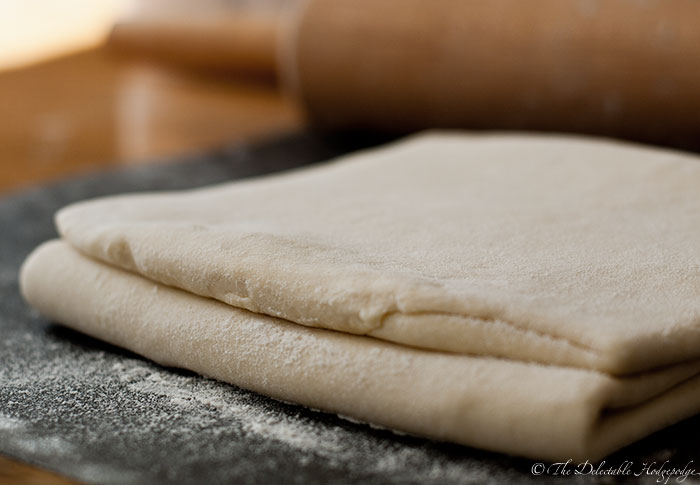
Pâte Feuilletée
| Ingredient | Two 9-inch pie pan sheets | Two 22-cm pie pan sheets |
|---|---|---|
| all-purpose flour | 8¾ oz. | 250g |
| salt | pinch | pinch |
| ice water | ½ cup | 125cc |
| butter | 2 Tbsp. + 14 Tbsp. | 30g + 200g |
Pâte Feuilletée is the famed French puff pastry. Developing the paper-thin layers of butter and flour that give it its deliciously flaky texture is time-consuming, but well worth the effort — it can turn a simple tart into something spectacular.
Preparation
- Mix salt and flour and sift into a large bowl; you can also whisk instead of sifting.
- Cut the 30g (2 Tbsp.) butter into pea-sized chunks.
- Put all ingredients in the refrigerator to chill.
Directions
- Make détrempe (flour-water dough).
- Mix the 30g (2 Tbsp.) of butter into the flour using the sablage method: Scoop up some of the mixture in one hand and rub your other hand across it; the dough should crumble into a parmesan-cheese-like texture. Continue until all the dough is evenly-textured; rub any larger chunks of butter between your fingertips to break them up.
- Add the ice water to the bowl and stir it together with your hand, then gather it into a ball; do not knead it.
- Use your fist to push down on the ball to flatten it somewhat, then fold it in half and flatten again; repeat 3-4 times. Stop before it becomes smooth; the surface should still be somewhat rough, and if you push on it lightly with a finger it should spring back slowly. Do this as quickly as possible, so that the dough doesn’t warm up.
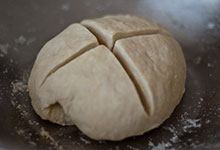 Gather the dough into a ball again and cut a 2cm (1-inch) deep cross into the top. Wrap tightly in plastic wrap and allow to rest in the refrigerator for at least an hour (even overnight is okay). Letting the dough rest makes it easier to roll out.
Gather the dough into a ball again and cut a 2cm (1-inch) deep cross into the top. Wrap tightly in plastic wrap and allow to rest in the refrigerator for at least an hour (even overnight is okay). Letting the dough rest makes it easier to roll out.
- Flatten butter into a square.
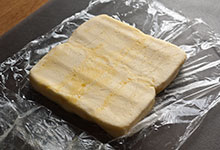 Place the remaining butter between two pieces of plastic wrap and, using a rolling pin, beat it into a flat square about 2cm (1-inch) thick; the square should be about 12cm (5-inches) on a side. Return to refrigerator to chill.
Place the remaining butter between two pieces of plastic wrap and, using a rolling pin, beat it into a flat square about 2cm (1-inch) thick; the square should be about 12cm (5-inches) on a side. Return to refrigerator to chill. - Add butter and fold.
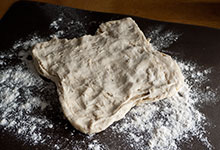 Dust a work surface with flour and place the chilled dough ball onto it. Peel back the ball from the scored cross to flatten it into a rough plus shape.
Dust a work surface with flour and place the chilled dough ball onto it. Peel back the ball from the scored cross to flatten it into a rough plus shape.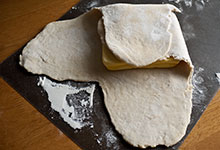 Dust the dough with flour and use a rolling pin to roll it into a plus shape, leaving the middle about four times thicker than the four leaves so that when it is folded into a package the top will be the same thickness as the bottom. The middle should be a little bigger than the square of butter and the leaves about as long as the middle, large enough so that when the butter wrapped in the leaves it is covered completely.
Dust the dough with flour and use a rolling pin to roll it into a plus shape, leaving the middle about four times thicker than the four leaves so that when it is folded into a package the top will be the same thickness as the bottom. The middle should be a little bigger than the square of butter and the leaves about as long as the middle, large enough so that when the butter wrapped in the leaves it is covered completely.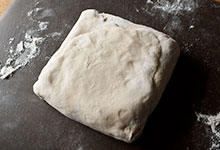 Place the square of chilled butter on the middle of the cross and fold the four leaves over it tightly; avoid trapping any air inside, and make sure the four corners are completely sealed so no butter will leak out.
Place the square of chilled butter on the middle of the cross and fold the four leaves over it tightly; avoid trapping any air inside, and make sure the four corners are completely sealed so no butter will leak out.- Dust lightly with flour and push down on the top with a rolling pin to bond the butter to the dough.
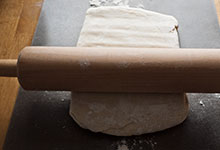 Roll out into a rectangle about 15cm by 50cm (6 by 20 inches); do this always rolling out from the center of the dough, alternating toward and away from you. Dust with flour as necessary to keep it from sticking to the rolling pin.
Roll out into a rectangle about 15cm by 50cm (6 by 20 inches); do this always rolling out from the center of the dough, alternating toward and away from you. Dust with flour as necessary to keep it from sticking to the rolling pin.- Dust off any excess flour and fold inward in thirds to make a square.
- Rotate the folded package 90 degrees, then repeat the process of rolling out into a similar-sized rectangle, rolling from the middle toward and away from you.
- Dust off excess flour again and fold in thirds into a square package again. Wrap the folded dough tightly in plastic wrap and allow to rest in the refrigerator for at least an hour.
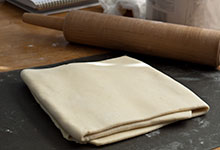 Repeat sub-steps 5 through 8 (folding and rolling it out twice, then letting it rest) two more times; it will be folded six times in total. Allow the dough to rest in the refrigerator, wrapped tightly, for at least two hours before using it.
Repeat sub-steps 5 through 8 (folding and rolling it out twice, then letting it rest) two more times; it will be folded six times in total. Allow the dough to rest in the refrigerator, wrapped tightly, for at least two hours before using it.
Notes
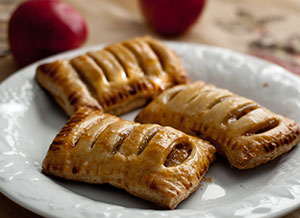
- This recipe was originally designed for a fifty-fifty mixture of cake and bread flours, but U.S. all-purpose flour works well.
- If you’re using U.S. standard sticks of butter the recipe as a whole uses two sticks (one-half pound); two tablespoons to start and then the remainder as a block.
- When making the shell for a tart or pie that isn’t baked after filling, bake using the following method: Do not use pie weights; prick the crust thoroughly with a fork and bake on the top rack for 10 minutes at 230°C (450°F), then move to the middle rack and bake another 15 minutes at 170°C (350°F). True to its name, it will puff up in the middle; push it down lightly with a spoon when you fill it.
- The dough can be prepared in advance and frozen. To do this, fold it four times out of the six (one trip to the refrigerator), then fold it in thirds, wrap it tightly in plastic wrap, put it in an airtight ziplock bag, and freeze. When you want to use it, allow it to completely thaw in the refrigerator first, then fold it two more times.
- For those interested in the math, the six foldings of the dough makes for 36 – that’s 729 – layers of butter, a good number for high quality pâte feuilletée. The miniature apple pies above are an example of a simple but delicious use for all that flakiness (recipe coming soon).
